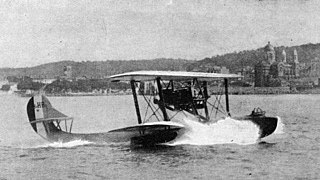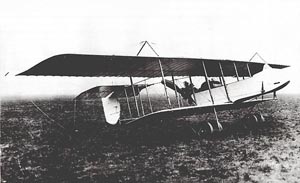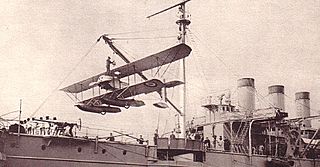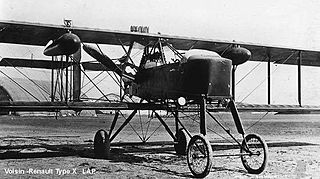| DO.1 | |
|---|---|
| Role | Armoured reconnaissance biplane |
| National origin | France |
| Designer | Émile Dorand |
| First flight | 1913 |
| Primary user | Aéronautique Militaire |
| Number built | at least 6 |
The Dorand DO.1 was an armoured reconnaissance-bomber designed and built in France from 1913. A small number were used operationally as a stop-gap measure.
General Bernard of the Aéronautique Militaire issued a specification for an armoured reconnaissance-bomber, with response from Blériot, Breguet, Clément-Bayard, Deperdussin, Ponnier, Voisin and Dorand. [1]
Capitaine Émile Dorand's offering, the DO.1, was an un-equal span biplane of wooden construction and fabric covering, with a slender square-section fuselage supported on struts between the negatively staggered mainplanes. [1] Power was supplied by an 85 hp (63 kW) Anzani 6-cylinder air-cooled radial engine, mounted in the nose. The pilot sat in an open cockpit under the trailing edge of the upper mainplane and the mechanic / observer sat in an open cockpit forward of the wings, protected from small arms fire by 90 kg (200 lb) armour plates. [1] Control was through conventional ailerons and rudder with an all-flying biplane tailplane providing pitch control. The undercarriage consisted of paired mainwheels mounted on struts, with skids between each pair of wheels and a tail-skid at the end of the fuselage. The DO.1 was found to be easy to fly, but seriously under-powered, resulting in a very short service life. [1]
Later, in 1916, the DO.1 was resurrected and re-designed as the Dorand AR.1 and AR.2, retaining many of the features of the DO.1 with a new fuselage and much more powerful engine. [1]
Do.1s were issued to Escadrille DO14 at Belfort on 14 December 1914, which used them in support of the 7th Armée at Hartmanswillerkopf and Rickhackerhoff in Belgium. DO14 replaced its DO.1s with Maurice Farman MF.11 in early 1915. [2] Six more DO.1s were issued to Escadrille DO22 at Villacoublay on 23 August 1914, flying operations in support of the 4th Armée in the Battle of the Marne. DO22 replaced its DO.1s with Maurice Farman MF.11 by 14 November 1914 and was re-designated Escadrille MF22. [2] A few DQ.1s were assigned to Escadrille V14 for escort duties but were quickly withdrawn from operations. [2]
In 1913 a DO.1 flown by Labouchère flew 1,800 km (1,100 mi) and a group of six aircraft led by Capitaine Leclerc flew 1,400 km (870 mi) in six stages. [3]
Data from Precursoraviation: The Dorand Do 1 - 1913, [3] Aviafrance:Dorand DO.1 [4]
General characteristics
Performance

The Voisin III was a French World War I two-seat pusher biplane multi-purpose aircraft developed by Voisin in 1914 as a more powerful version of the 1912 Voisin I. It is notable for being the aircraft used for the first successful shooting down of an enemy aircraft on October 5, 1914, and to have been used to equip the first dedicated bomber units, in September 1914.

The Maurice Farman MF.7 Longhorn is a French biplane developed before World War I which was used for reconnaissance by both the French and British air services in the early stages of the war before being relegated to service as a trainer.

The Blanchard Brd.1 was a French reconnaissance flying boat, to the 1923 STAé HB.3 specification, used by the French navy in the 1920s. It was a large biplane with two engines mounted in the gap between the wings, each engine driving a pusher propeller. In 1924, one Brd.1 was used to set several world altitude records for seaplanes.

The Dorand AR.1 was a World War One French two-seat observation biplane aircraft used by the French Air Force, the American Expeditionary Force and, in small numbers, by Serbian Aviation.

The Farman HF.20 and its derivatives were a family of reconnaissance aircraft produced in France shortly before and during the First World War. It was a refined version of the Farman MF.11 "Shorthorn" that did away with the type's distinctive landing skids, and incorporated design features from Henri Farman's designs. It entered service with the French, Belgian and Serbian armies in 1913, and with the British RFC and RNAS shortly after the outbreak of war. The type was also licence-built in the UK by Airco and Grahame-White.

The Hanriot HD.14 was a military trainer aircraft produced in large numbers in France during the 1920s. It was a conventional, two-bay biplane with unstaggered wings of equal span. The pilot and instructor sat in tandem, open cockpits, and the fuselage was braced to the lower wing with short struts. The main units of the fixed tailskid undercarriage were divided, each unit carrying two wheels, and early production examples also had anti-noseover skids projecting forwards as well.

The Farman NC.470 was a French twin-engined floatplane designed as a crew trainer for the French Navy. It was used in small numbers for both its intended role as a trainer and as a coastal reconnaissance aircraft at the start of World War II.

The Caudron J Marine was an amphibious, two-seat, biplane equipped with floats and wheels, simiar to the earlier Caudron J floatplane.

The Farman F.30A C2 was a two-seat biplane designed as a fighter in France in 1916 and powered by a single, water-cooled radial engine. It showed poor flight characteristics and only one was built, though it was modified twice. It should not be confused with the similarly named Henry Farman HF.30 of 1915, a completely different aircraft which was used in large numbers by the Imperial Russian Air Service.

The Farman FF 65 Sport was a French built light biplane, with a single engine and tandem seats, intended for sport and touring. First flown in 1919, it achieved modest sales at home and abroad in the early 1920s. Two unusual modifications produced a biplane glider and a low aspect ratio parasol wing machine.

The Farman HF.14 was a French two seat reconnaissance type produced by Farman Aviation Works before World War I.
The Hanriot H.34 was a basic trainer designed in France in 1924 which did not reach production. It was a parasol wing aircraft, seating two in tandem.
The Blériot 71 was a large First World War French heavy night bomber designed and built by Blériot to the BN3 specification. Only a single prototype was built, which was damaged beyond repair on 15 May 1918.
The Blériot 73 was a large First World War French heavy night bomber designed and built by Blériot to the BN3 specification. Only a single prototype was built, which crashed on landing from its first flight, killing the pilot. The Blériot 74, Blériot 75 and Blériot 76, respectively, a heavy bomber / airliner, airliner and heavy bomber, directly evolved mfrom the Blériot 71 / Blériot 73 bombers.

The Voisin VIII was a French two-seat biplane pusher which was built in two versions, one fitted with a 37mm Hotchkiss cannon, and the other as a conventional bomber. Problems with the Peugeot engine led to a short operational career with front line units before being superseded by the Voisin X, which aside from the installation of a new Renault engine, was nearly identical to the VIII.

The Voisin X was a French two-seat pusher biplane which was built in two versions, one fitted with a 37 mm (1.46 in) Hotchkiss cannon, and the other as a conventional night bomber. Problems with the Peugeot engine in the previous Voisin VIII led to the installation of a new Renault engine of greater power and reliability, but the new aircraft was otherwise nearly identical to the VIII. Despite its obsolescence, it would make up the bulk of front line night bomber escadrilles until the end of the war.
The Henri Farman HF.35 was a large 3-seat biplane designed and built in France by Henri Farman during 1915.
The Maurice Farman MF.8 was a biplane floatplane,with a pusherengine, designed and built in France circa. 1913.
The Maurice Farman MF.9 is a French tourism biplane developed by Maurice Farman before World War I. Like the Maurice Farman MF.6, it used floats for take-off and landing on water.
The Paul Schmitt P.S.7 was a French World War I two-seat biplane bomber that dispensed with the novel variable incidence wing used on prior designs.